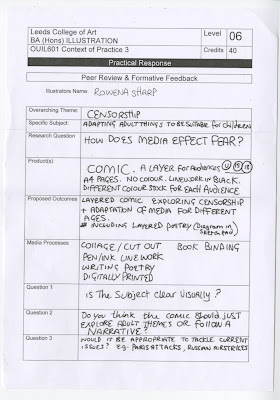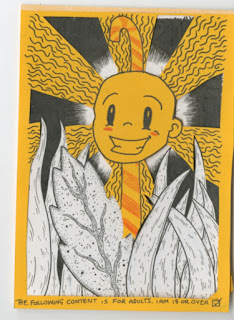I put my theme as censorship because I guess thats what this has become. My essay is exploring how media effects fear and discusses how things are adapted in relation to fear. And I guess the adapting has bled through into being a censorship issue. I proposed my layered comic, I've decided that the layering will be on both words and image. I was thinking like having a poem on each page and heres cut holes in the higher layers in places where the same word has been used. But at this point I wasn't sure if I wanted to create a narrative or to just have chosen subjects to do it on. And whether or not I should generalise it or have it on specific happenings now, like the paris attacks.

Zatul filled out one of my feedback forms.
Things she said:
Look into movies that share a strong link with your subject
Specify your target audience
Go more gross
Try colour
Package it professionally
Try making a few different comics
What I will do in respect to this:
Define my audience which I'm pretty sure is adults because obviously it would need to be censored for children.
I'm going to look at more horrifying things in movies, like saw games etc
I may try to explore colour in relation to what it emotes. Like finding the right stock for each layer of comic. Then i might play with shading and bitmapping it so it works on the coloured paper.
Separate my ideas into multiple comic ideas. Just try lots of different idea til something fits.
Sophie also filled out one of my feedback forms.
Things she said:
Figure out where you are going with this
Consider advertising and campaign as a media
Do more thumbnails and quick idea generation
Don't labour too long over non-final images
Don't think this would work as a comic
Look at banned adverts especially for sti's
What i will do in respect to this:
I will figure out what my opinion is and what i want to convey overall.
I don't really have an interest in advertising and I want this to be more of a social comment on the state of affairs so I probably won't be doing adverts. But adverts is a good point to make as some are only shown after certain times to protect children.
I need to do some quick work and just blast out a load of ideas so that I have a book of visual thinking to work off of.
Research more things that are censored to protect children.




















